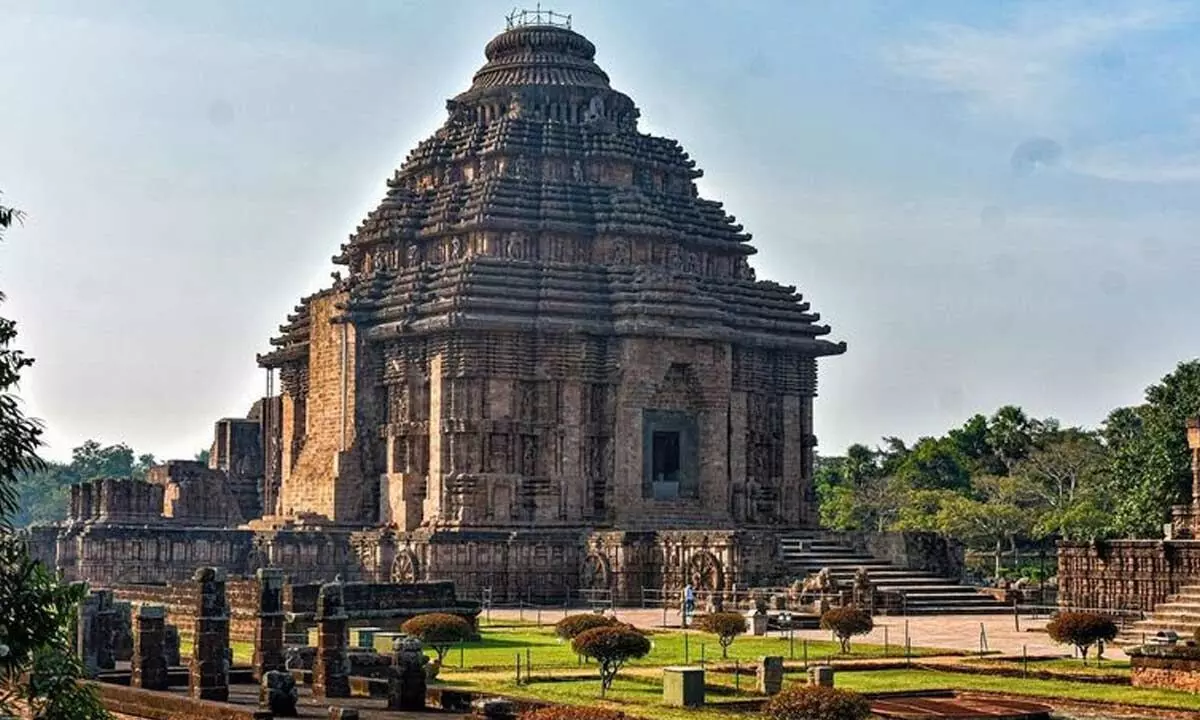Live
- New Criminal Laws: An Era of Transformation of the Criminal Justice System
- India among top 10 countries with AI readiness: Report
- UNICEF to support Kerala's children with special needs
- Meta purges over 2 million accounts linked to scam centres
- Mumbai, Delhi ranked among top 5 prime residential markets in Asia-Pacific
- Russia provided North Korea with anti-air missiles in exchange for troop deployment
- PCB appoints Azhar Ali as head of youth development
- Deepam-2 Scheme Reaches 5 Million Beneficiaries in Three Weeks, says Nadendla Manohar
- Will RG Kar tragedy impact Bengal bypoll results?
- BGT 2024:25: Josh Hazlewood picks four as Australia bundle out India for 150
Just In
The Significance of Sun Temple Konark in Our Daily Life


The Sun Temple of Konark, an architectural marvel located in the eastern state of Odisha, India, stands as a testament to the ingenuity, artistry, and spiritual fervor of ancient Indian civilisation.
The Sun Temple of Konark, an architectural marvel located in the eastern state of Odisha, India, stands as a testament to the ingenuity, artistry, and spiritual fervor of ancient Indian civilisation. Built in the 13th century by King Narasimhadeva I of the Eastern Ganga dynasty, this UNESCO World Heritage Site is not just a relic of the past but continues to hold significant relevance in our daily lives today.
Architectural Grandeur and Inspiration
The Sun Temple, also known as the Black Pagoda, is renowned for its intricate carvings, colossal structure, and unique design. The temple is shaped like a giant chariot, with twelve pairs of elaborately carved stone wheels pulled by seven horses. This architectural wonder serves as a source of inspiration for modern architects and engineers, showcasing the advanced engineering skills and aesthetic sensibilities of ancient builders.
1. Architectural Influence: Modern architects draw inspiration from the temple’s design, incorporating elements of its symmetry, balance, and detailed carvings into contemporary structures.
2. Cultural Heritage: The temple’s design and craftsmanship highlight the rich cultural heritage of India, reminding us of our historical roots and inspiring pride in our ancestry.
Symbolism and Spirituality
The Sun Temple is dedicated to Surya, the Sun God, symbolising energy, vitality, and life. The temple’s orientation towards the east, allowing the first rays of the sun to illuminate the main entrance, signifies the importance of the sun in daily life and its role in sustaining life on Earth.
1. Daily Rituals: The worship of the Sun God emphasises the significance of sunlight in daily routines, promoting practices like Surya Namaskar (Sun Salutation) in yoga, which integrates physical exercise with spiritual well-being.
2. Spiritual Enlightenment: The temple serves as a reminder of the spiritual connection between humans and nature, encouraging mindfulness, meditation, and a holistic approach to life.
Education and Learning
The Sun Temple is not just a place of worship but also a repository of knowledge and learning. Its walls are adorned with carvings depicting various aspects of life, mythology, and the natural world, serving as an educational tool for visitors.
1. Historical Knowledge: The carvings and inscriptions provide insights into the social, cultural, and religious practices of ancient India, offering valuable lessons for historians, scholars, and students.
2. Scientific Awareness: The temple’s architecture and alignment demonstrate the advanced understanding of astronomy and mathematics possessed by ancient Indians, fostering an appreciation for scientific knowledge and innovation.
Cultural and Economic Impact
The Sun Temple of Konark plays a vital role in the cultural and economic landscape of modern India. It attracts tourists from around the world, contributing to the local and national economy and promoting cultural exchange.
1. Tourism: The temple is a major tourist attraction, generating revenue and creating job opportunities for the local community. It also boosts the hospitality and handicraft industries in the region.
2. Cultural Festivals: Events like the Konark Dance Festival, held annually at the temple, celebrate classical Indian dance forms, preserving and promoting India’s rich cultural traditions.
Environmental Awareness
The temple’s association with the Sun God underscores the importance of respecting and preserving the natural environment. It serves as a symbol of sustainable living and the harmonious coexistence of humans and nature.
1. Renewable Energy: The significance of the sun in the temple’s design inspires modern initiatives to harness solar energy, promoting renewable energy sources and reducing reliance on fossil fuels.
2. Environmental Conservation: The temple’s message of reverence for nature encourages environmental conservation efforts, fostering a sense of responsibility towards protecting the planet for future generations.
Conclusion: The Sun Temple of Konark is more than just an ancient monument; it is a living symbol of India’s rich cultural heritage, architectural brilliance, and spiritual depth. Its significance permeates various aspects of daily life, from inspiring modern architecture and fostering spiritual practices to promoting education, tourism, and environmental awareness. As we continue to draw lessons from this timeless masterpiece, the Sun Temple of Konark remains a beacon of inspiration, guiding us towards a future that honors our past while embracing progress and sustainability.

© 2024 Hyderabad Media House Limited/The Hans India. All rights reserved. Powered by hocalwire.com






